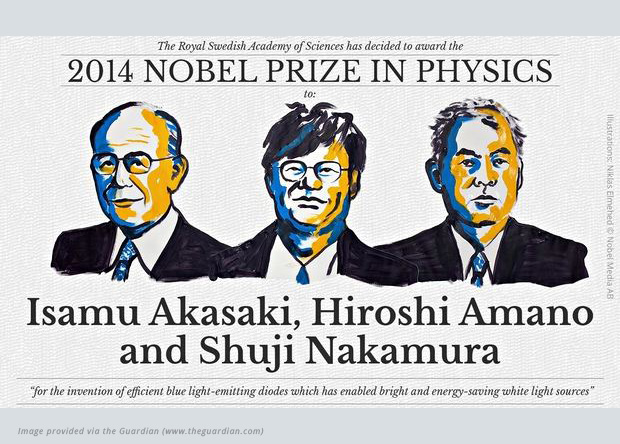There is something especially heartwarming about seeing people rewarded for their tireless, dedicated work, especially if that work contributes to making the world a better, cleaner, more energy efficient place. The 2014 Nobel Prize in Physics was no exception. Last October, it was awarded to Isamu Akasaki, Hiroshi Amano, and Shuji Nakamura for the invention of efficient blue light-emitting diodes (LEDs). Akasaki is a Distinguished Professor at Nagoya University in Japan along with Amano, who was a Ph.D.-student at the time of the discovery. Nakamura is a Professor at the University of California, Santa Barbara. All were honored with the Nobel Prize in Physics for creating the little blue light that has made the biggest impact on the evolution of LED.
Why is blue light so important? Well, it’s one of the three colours (in addition to red and green) necessary to produce the white light we rely on every day. While study of light emitting semiconductors started as early as 1907, researchers soon realized that the elusive blue diode was the key to unlocking the true potential of LED.
Despite many challenges, the Laureates persevered and, as the Nobel Prize press release explains, they “… challenged established truths; they worked hard and took considerable risks. They built their equipment themselves, learnt the technology, and carried out thousands of experiments. Most of the time they failed, but they did not despair; this was laboratory artistry at the highest level.” To appreciate the magnitude of their accomplishments, understanding the challenges associated with creating light in a semiconductor is important.
The magic of LED technology is based on quantum phenomena. A light-emitting diode is made of layers: an n-type layer with an excess of negative electrons, and a p-type layer with an excess of positive holes. Between them is an active layer, which attracts both the negative electrons and the positive holes to it when an electric voltage is applied. When electrons and holes meet, they reconnect and light is created. Blue light appears at the short-wave end of the spectrum and can only be produced in specific materials.
The material of choice for the Laureates was gallium nitride, which was generally considered up to the task, but was wrought with challenges. For example, it was deemed nearly impossible to grow gallium nitride crystals with the appropriate quality level or create p-type layers in them. While others moved on and started working with alternative materials such as zinc selenide, the Laureates persevered until it paid off.
In 1986, Akasaki and Amano successfully created a high-quality gallium nitride crystal by placing a layer of aluminum nitride on a sapphire substrate and then growing the high quality gallium nitride on top of it. A few years later, they were successful in creating a p-type layer. Quite by accident, Akasaki and Amano discovered that their material glowed more intensely when it was studied in a scanning electron microscope, which suggested that the electronic microscope beam was increasing the efficiency of the p-type layer.
Nakamura began working on his blue LED in 1988 and discovered an alternative way of creating high quality crystals by growing a thin layer of gallium nitride at low temperature and growing additional layers at a higher temperature. He also uncovered the science behind Akasaki and Amano’s discovery with the electron beam and their p-type layer: the beam removed the hydrogen that was preventing the p-type layer to form. Nakamura found an alternative solution by heating the material so he was able to create a functional p-type layer in 1992. The 1990s found both research groups honing their methods and making important innovations and improvements. The Laureates went on to invent a blue laser, which led to the development of Blu-ray discs, as well as high quality laser printers.
It’s been just over 20 years since the first bright blue beams shone from their semiconductors, but since that time, the vast number of applications continues to grow: from televisions to smart phones; streetlights to greenhouses; water sterilization to lighting that adjusts to our natural biologic clock – it’s amazing something the size of a grain of sand has contributed so much. It’s also a testament to the power of determination, ingenuity and perseverance of people like Akasaki, Amano and Nakamura. May their contribution continue to inspire and may the mighty LED’s future continue to shine brightly with each new innovation to come.
About The Author

-
Serial Entrepreneur, Technologist and Inventor.
My objective is to develop useful products that have a net positive effect in the lives of those that use them and the environment that we live in.
CEO of Mission LED Lighting Company Ltd.
- 2017.05.24LED factsWhy Are Cars Switching to LEDs if They’re Too Bright?
- 2017.05.09Be green & saveHow to Easily Replace T8 Fluorescent Tubes With LED
- 2017.03.07Build a better future7 Things About Explosion Proof LED Lighting You Should Know
- 2017.02.28Be green & saveWhy We Love LED Grow Lights (And You Should, Too!)





Leave a Reply